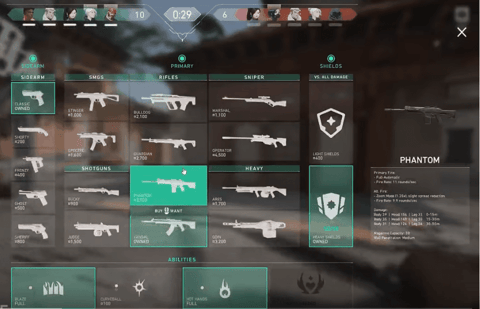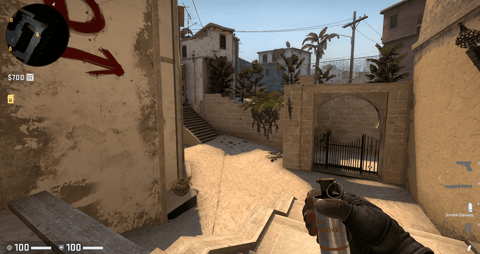
Ever since it was announced Valorant was labeled as a CS:GO clone. How different are the two shooters really?
There’s no denying that Riot drew inspiration from the most successful shooter on the market – Valve’s CS:GO. The latter has been around since the start of the millennium and a whole generation has practically grown up with it. It’s no easy task to improve upon what’s already regarded as the best and in some areas Riot did the wise thing by just copying elements from CS:GO.
Servers
CS:GO runs on 64-tick community servers. Only the pro scene and third-party platforms like FACEIT offer the 128-tick goodness. Valorant’s main selling point has always been that the game will support 128-tick servers for everyone.
Anti-cheat
CS:GO’s anti-cheat is as mysterious as Valve themselves. You can report players you suspect of cheating and there’s a separate system called Overwatch. In it, players that meet a certain criteria like hours played, experience and rank will be the judge over a replay of the suspect. In Valorant, things are simpler but much more intrusive. Riot developed an anti-cheat specifically for Valorant called Vanguard. It runs in the deepest level of your system, starting when you boot your computer and it’s always active. Needless to say, a lot of people aren’t happy with that and Riot will probably incorporate some changes in the upcoming patches.

Game economy
CS:GO isn’t just a shooter, but a tactical one. Communicating with your team and thinking of the rounds ahead are both key components to victory. Things like “eco” rounds are used to save up enough money for a decent weapon in the next one. Valorant has made it even easier to call it out as there’s a direct option to notify your teammates that it might be a good idea to go “eco”.
In both titles winning gives you a set amount of money. Losing starts low, but the more lose the more money you get. Planting the bomb/spike will net you in some extra cash too. Last but not least, it’s kills. They can be a huge factor in CS:GO as the amount you get varies greatly depending on the weapon you used. Killing someone with a knife in competitive gets you $1500 which is a lot. For comparison, pistol kills give $300, SMG’s $600, and something like the AWP only $100. In Valorant the amount you get per kill is always static, standing at 200 credits.

Weapons / Hitboxes
Some of the weapons in Valorant are a copy of CS:GO ones with extra steps. The famous AWP (heavy sniper) from Valve’s title is known as Operator in Valorant. Operator, get it? Cause it’d be OP for short. The Valorant version also has a short delay before it’s actually accurate when scoping. Both weapons kill with one shot in the body, except in the rare cases when you hit a hand or a foot. This brings us to our next topic – hitboxes. In CS:GO there’s four of them – head, torso, abdomen and legs. In Valorant there’s only three – head, body, legs. Clearly the abdomen is missing and for anyone coming from CS:GO this might feel awkward at first.

Accuracy
In both games, weapons function similarly when it comes to aiming. There are three types of inaccuracy in the two games – spread, recoil, and movement inaccuracy. The latter is pretty self-explanatory and prevents run & gun with most weapons. Spread is the natural inaccuracy of the weapon which cannot be controlled. Recoil comes as a result of continuous firing. The recoil pattern can be controlled if you developed the proper technique but that will take some training and getting used to. Tagging (the slow which results in after you receive a shot) is much stronger in Valorant. Anyone hit by a bullet will be almost stopped in their tracks, making it very difficult to escape unless you're Jett as she has access to a quick dash. In CS:GO you get slowed, but it's nowhere near as harsh as in Riot's shooter.
Wall-banging
Weapons in both titles have varying degrees of armor penetration. You can shoot through some walls in CS:GO which will allow you to hold better control of some points. In Valorant wall-play is a much bigger element as many of the agents have abilities that go through walls - those can be simple flashbangs, damage, slow and more.
Utility
Everyone in CS:GO has access to flashbangs, molotovs, grenades, smokes, and decoys. In Valorant utility is limited to your character’s abilities. Some will have a flashbang, others a molotov, but so far there’s no character that incorporates every type. This is no doubt a decision by Riot made to encourage team play and coordination. There’s just one thing missing.

Friendly fire
Friendly fire adds a certain dose of realism to the game. Sometimes it’ll make you choose between hurting a teammate and taking out an enemy. CS:GO has friendly fire with weapons and grenades. In Valorant weapons cannot hurt your allies, but area of effect abilities like Raze’s ultimate can be deadly even to your team. Since Riot are aiming to make their new shooter a competitive one with a well-established scene, adding friendly fire will be a must.
As you can see the similarities between the two titles are more than the differences. Abilities in Valorant are mostly utility-oriented and only ultimates can be a game-changer like Sage’s which can bring a teammate back to life. Which one do you prefer? Do you think Valorant will be the next big thing or will its popularity sink months after the official release? Stay tuned for more Valorant news.






























